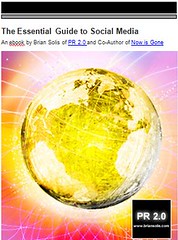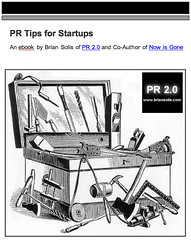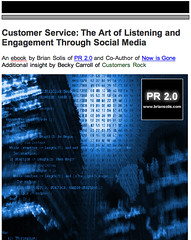Social Media Killed the Video News Release Star

Source
With Social Media Releases (New Media Releases) in the spotlight again, I felt this was the ideal timing to introduce you to the Video News Release (VNR) redux. Ready or not, start brushing up on flash, screencasting, video production, online video networks, and Web marketing.
Online video is the next frontier for the communications industry adding a new layer of engagement to any existing PR, marketing and web initiative. In my opinion social media has reinvented the VNR, putting the power of creation and distribution in the hands of those with a camera, PC, and a broadband connection - well, and a little marketing savvy and an understanding of the pains and needs of the people they're trying to reach...
What the social media press release is to traditional releases, amateur video, screencasts, and demos are to traditional video news releases (VNRs).
For those who may not have direct experience with VNRs, they are an age-old, somewhat effective tool for telling a story visually and are directly related to many of the stories that you see on traditional broadcast news networks. While effective, they are incredibly expensive - especially in the Web 2.0 genre. Production segments, b-roll, satellite transmission, and not to mention the legwork associated with calling attention to the distribution time of transmitting the feed, easily hits the $20k mark for one story.
I've long said that for the right marketers, Youtube, and the other video networks out there, represent what could be constituted as the new broadcast channel for social video news releases. And with the technology barriers of entry are so low (in terms of expertise required and cost of equipment), there's never been a better time to experiment with video.
However, like all forms of social media, it requires a level of understanding, ethics, and transparency that can only be possible with hands-on experience - not as a marketer, but as a participant of all forms of social media.
While many readers of PR 2.0 are in the tech industry, the entire concept of social media VNRs can benefit any business.
At the very least, social video allows companies to demonstrate their product in a way that is consumable, shareable, and also much more interesting than reading collateral.
Let's take a look at a few of the more popular videos online (keep in mind, it's less about quality and more about participating and contributing):
Aside from video, screencasts are also viral and effective. Here are a couple of examples:
SiteKreator
Ning
Robert Scoble encourages PR and corporate marketing to engage by saying that we should worry less about trying to have broadcast quality production and focus more on the uniqueness of a product when pursuing campaigns through online video. Even Michael Arrington of TechCrunch supports the use of corporate marketing through video and often runs the more creative shorts on his personal blog, CrunchNotes.
However, it's not just about getting the attention of bloggers and traditional media. It's also a way of reaching the markets, and more importantly, the people that can benefit from the product/service. That's the beauty of a social network.
According to a past issue of PRWeek, Nuance scored 35,000 views on YouTube from a very targeted audience and MultiVu’s work for NVIDIA earned 65,000 viewers off Metacafe.
Here's the Nuance video:
There are several ingredients to consider when developing a video or screencast, and the choices you make for their implementation will determine the success or failure of the campaign.
1 - Be genuine. This isn't yet another opportunity for PR to spam the world
2 - Know your targets, their pain points, and why your product will help them. And please don't use the word audience. Viewers today are considered the people formally known as the audience. This ensures that we engage by conversing with, not marketing to, people. This is Jay Rosen's philosophy, which many social media purists hold sacred when discussing how to participate through social media.
3 - Keep it focused on what's unique, interesting, and compelling.
4 - Experiment. Don't just stop at one...keep the line of communication open through video much in the same way you would with blogs, marketing collateral, newsletters, and press releases.
5 - Place the videos on the company site and offer RSS feeds for them.
6 - Ensure that the videos are placed in the social networks where the people you want to reach search for new and interesting content.
7 - Simply placing videos online isn't enough. Just because you place in social networks doesn't mean it will be viewed and shared. You have to do "PR" for it through the folksonomy of strategic tagging, linking, and having others point to it and republish it to spark the viral potential of your content.
8 - Be creative.
9 - Worry less about polish and more about content.
10 - Listen to feedback
While social video represents a new opportunity for marketing and PR, I can not emphasize enough the importance of maintaining traditional programs and fostering relationships with analysts, reporters, bloggers, and customers. Video can only enhance a proactive and all-encompassing marketing and PR campaign.
Social media is indeed breathing new life into Video News Releases and with that, it continues to reinvent PR for the new Web.
Lights. Camera. Action.
Update: Marshall Kirkpatrick documents how video and social media helped SplashCast rise above the noise.
Also, thank you to videographer Mikko Wilson for the artwork used in the original post.
wrike techcrunch nuance youtube vnr video videonewsrelease video+news+release lcd epaper smr smpr social media socialmedia social+media 2.0 media2.0 media+2.0 pr pr2.0 pr+2.0 brian+solis ning social+networks networks prweek sitekreator robert+scoble michael+arrington screencasts hrelease press+release pressrelease news+release












8 Comments:
Good insights, Brian. Thanks for the post.
Thanks Brian, very interesting post. A company that is getting video based PR spot on is blendtec (www.willitblend.com).
It's time to get camera training. This should be a requirement for any communications school these days. Good advice on balancing traditional programs with the new. Always poignant, Brian.
Scott, thank you!
Nic Ray, I'll check them out.
Geoff, you're right. Or at least start by consuming to see what works. Thanks for the nice words!
Brian,
Wise words - as always. I am going to post this to the Daily 'Dog.
Let's talk about this at SMC Wednesday night in LA. I look forward to seeing you there.
Sal
Sally Falkow
PRESSfeed
Excellent post, Brian. I've been in the PR video space since I left network broadcast news in 1987, and I can't remember a more suitable platform for the old 1:30 narrated VNR intended for TV news broadcasts than the full spectrum of web 2.0 applications. Bite-size chunks of broadcast quality video that succinctly tell audience-appropriate compelling stories in brands are ideal for corporate and media websites, social and viral media, downloading, podcasts, etc. The Internet and its wealth of communities and applications breathes new life into a format that has tremendous advantages for end users and publishers alike, and can then be leveraged across other digital platforms such as venue-based and out-of-home networks. We're enjoying evangelizing the rebirth of the format in the wake of the Internet video boom.
Nick Peters, SVP Marketing & Strategy, On The Scene Productions
On The Scene Productions
addendum to above that I neglected to include: we counsel our clients from a production and content standpoint that the value of the VNR as a communications vehicle to online communities will obviously depend on the PR practitioner's understanding that in this world, the VNR cannot intend to spin...the story has to be published with the understanding that communities of free spirits in the social media space will see in it what they will, and use it accordingly...or not. The goal is to create discussion and buzz, and not to try and impose a commercial point of view. nick
Brian,
You bring up some very interesting points. I am a senior public relations student and I am constantly learning about the new forms of news releases and social media. We are focusing on blogs and podcasts in order to prepare us for the new age of the news release. I think it is still very important to blend both the traditional release with the new. Very nice post.
Post a Comment
<< Home